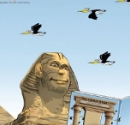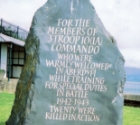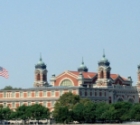WAR & PEACE: Barricades, Fences & Round Tents in Square Glass Holes
Category: Diaspora Issue No. 159
Inside the spacious tent at St.Ethelburga
From Barricades in Belfast to the London Student Protests and St. Ethelburga’s Center for Reconciliation and Peace - in one week
Seeing it somewhere else where the conflict is sort of on hold – made me stand back and take a good look at how those I deal with from abroad react to seeing the security fence, checkpoints and ominous concrete wall snaking its way across Jerusalem.
In a smallish courtyard just off a main road in Bishopsgate, London - tucked in between high-rise office blocks that seem to be made almost entirely of glass - sits a rather large, round and highly unusual tent. No I am not mistaken, most definitely a tent and a rather attractive one at that. Finding the creative canvas oasis of tranquility for the first time is no easy feat, since in order to get from the bustling main road to the courtyard one has to enter a very narrow alleyway between buildings, one of which is St. Ethelburga’s church.
The courtyard and the tent belong to the St. Ethelburga’s Center for Reconciliation and Peace, a center that aims to inspire and equip people to practice reconciliation and peace-making in their own communities and lives, one way of which is to champion effective means of building relationships between people from different backgrounds across boundaries of faith, tradition and culture.
When representatives of the Center for Reconciliation and Peace approached the Saudis requesting a few thousand pounds as a donation towards the building of a tent in the middle of a busy commercial area, they refused. “Actually, they said they wouldn’t give money but would give the tent,” Simon Keyes, the director of St. Ethelburga’s explained with a wide smile.
How I came to be visiting St. Ethelburga is connected to my work at the Givat Haviva Institute’s Jewish-Arab Center for Peace but before arriving there I had spent a week in Dublin and Belfast as a guest speaker at events celebrating the 100th anniversary of the kibbutz, as I am a member of such a community for over 40 years I am proud to say.
An interfaith group from St. Ethelburga’s had visited Givat Haviva the week before I left for Dublin. Numbering a round dozen - 4 Jews, 4 Christians and 4 Muslims, I spent time with the group on campus and guided them on a tour of the surrounding region.
One of the Jewish participants, Belgian-born Manchester University student Marco Schneebalg, had spent a year in Israel together with other members of his Hashomer Hatzair movement group of contemporaries from Europe. During his first year at Manchester University Marco cofounded a Jewish-Muslim dialogue group at the university and was invited by the St. Ethelburga’s center to join their Israel trip.
I had the misfortune, however, to get caught up in a large student demonstration on the streets of London on my way there. After being shoved rather rudely by a couple of policemen who thought I – a 65 year-old grandma – was directly involved (some compliment) and a few minutes later almost decapitated by an agitated student waving a large wooden sign, I ducked into an already crowded coffee shop and waited until the streets were a little less threatening. I had arranged to meet Marco, who had come down from Manchester to both participate in the student demonstration and attend the meeting of his fellow travellers to Israel the previous month from St Ethelburga.
When in Belfast, I was taken on a tour of the city and thought that I knew something about ‘the Troubles’. However, during a physical, visual and emotional sojourn to the Falls and other areas, the names of which I recognized from the terrible events of the city’s past I realized that I knew very little. The irony was not lost on me that the group from St. Ethelburga’s center had told me that when they were in Israel, that the medieval church, one of the few which had survived the Great Fire of London in 1666 and had suffered bomb damage during the London Blitz during the Second World War and been restored in 1953, had been almost completely destroyed by a devastating bomb set off by the IRA (Irish Republican Army) in Bishopsgate in April, 1993. The Church of England had proposed demolishing the remains of St. Ethelburga’s Center – the insurance policy on which had run out just three weeks before the bombing - but following a public outcry it was rebuilt to its original plan although with the interior somewhat different.
Over 50,000 people from dozens of countries, many of them countries in conflict, have visited the Center for Reconciliation and Peace that arose from the ruins of the IRA bombing and which is completely independent of the Church of England although the church itself remains a consecrated Christian space.
People come together to share their stories, experiences, insights and skills about how to build a relationship across divisions of conflict and religion. St. Ethelburga’s Center has become a powerful symbol of how the chaos of conflict can be transformed into a new creative order.
“Our experience and ideas come from listening to these people, rather than from any particular theoretical or theological position,” explains Simon Keyes.
“We offer a safe place for a new type of conversation in which people can have an opportunity to build relationships with people unlike or even opposed to them.”
During the visit to Belfast – and even though I had seen the so-called ‘peace wall’ and famous murals of Belfast on television news reports – seeing for myself the massive murals with their powerful portraits of one person's hero and another's enemy, republican and loyalist living a few streets apart, divided by a wall, fence and in the middle of an access road a number of large steel pillars.
Confused as to what they were doing in the middle of the road, my companion explains that these steel girder-type 'whatevers' can swing around at the touch of a button – somewhat like the Thames Barrier blocking out rising sea waters so as not to flood London. I found it all shocking, horrific and yet … am I not dealing with the same physical sights (minus the swinging girders) in much of my work in Givat Haviva in Israel?
Seeing it somewhere else where the conflict is sort of on hold – nobody I spoke to thought it was the end of ‘the Troubles’ altogether – made me stand back and take a good look at how those I deal with from abroad react to seeing the security fence, checkpoints and ominous concrete wall snaking its way across Jerusalem.
Shared scars of the past and evidence of the ongoing fears and distrust carried by people in conflict moving forward to the next round of physical confrontation whilst at the same time declaring that they are seeking peace.
I guess I don’t have the answers to many of my own questions never mind those of others.
Too many swords and not enough ploughs.
 dear editor 159 magazine
dear editor 159 magazine OVERNIGHT OAT & SESAME BARS
OVERNIGHT OAT & SESAME BARS IN THE SWIM
IN THE SWIM (302x450)-1451381711.jpg) Odeon Oscar
Odeon Oscar The Jewish Connection
The Jewish Connection ellis island
ellis island Lydia Aisenberg
Lydia Aisenberg